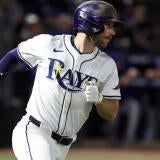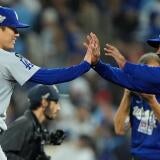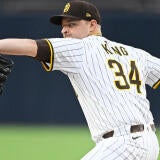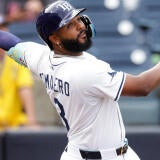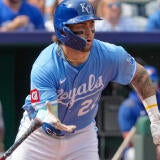2022 Fantasy Baseball Prospects: Top 30 at pitcher includes Shane Baz, Grayson Rodriguez, Jack Leiter
You thought the position was volatile before ...
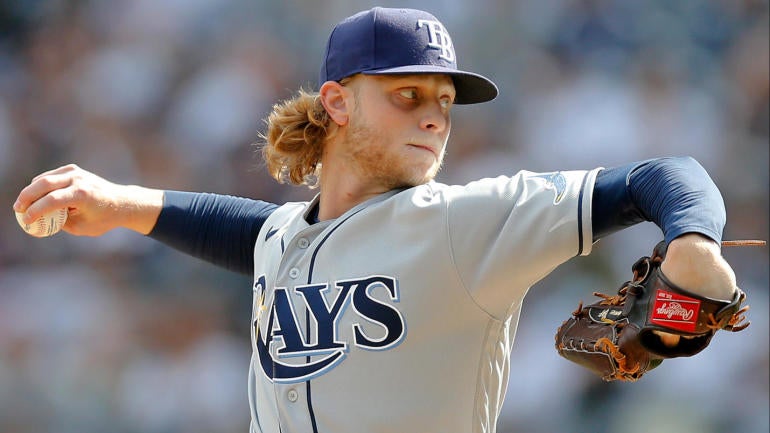
Half of all prospects are pitching prospects, so the saying goes. I believe I coined said saying.
Here's a more famous one that didn't come from me: There's no such thing as a pitching prospect.
It may not sound like it, but they're two sides of the same token. The latter speaks to the volatility of the position, the former to its need for redundancy ... because of said volatility. In every organization, you'll find the same: piles of pitchers.
In the past, it's made for the torturous task of narrowing this list down to 30, but a new variable has emerged recently that takes the pressure off. While all pitching prospects used to settle into one of two roles, starter or reliever, a sizable portion now, perhaps even the majority, will slide into a third category somewhere between the two.
Top prospects: C | 1B | 2B | 3B | SS | OF | P
It means longstanding concerns like durability and pitch development don't matter quite like they used to, widening the scope of relevant talent. But it also means much less of that talent will make a real difference in Fantasy. What good was stashing a pitcher who goes on to throw only four innings at a time?
The entire pitching prospect pool has largely flattened because of it. None of them matter because all of them matter. And apparently, I'm not alone in feeling this way. Even conventional (i.e., non-Fantasy) prospect rankers like Baseball America and MLB.com currently include only about 30 pitchers in their top 100 overall. So much for "half of all prospects."
But of course, it's not literally true that no pitching prospects matter anymore. It's just that the ones who do, whether because their upside is so considerable or their role is so well defined, are relatively few -- not much more than these 30, I'd say. And of course, even for them, it's likely several will slip into that no-man's land between starter and reliever, perhaps even ping-ponging between the two roles. No bueno.
Invest cautiously is all I'm saying.
Note: This list is intended for a variety of Fantasy formats and thus weighs short-term role against long-term value. Not all of these players will contribute in 2022 — most, in fact, will not — but among prospects, they're the names Fantasy Baseballers most need to know.
1. Shane Baz, Rays
Age (on opening day): 22
Where he played in 2021: Double-A, Triple-A, majors
Minor-league stats: 5-4, 2.06 ERA, 0.80 WHIP, 78 2/3 IP, 13 BB, 113 K
Major-league stats: 2-0, 2.03 ERA, 0.68 WHIP, 13 1/3 IP, 3 BB, 18 K
Having previously rocketed up rank lists because of the same sort of arsenal tweaks that worked for Tyler Glasnow, Baz once again elevated his profile with control so improved it inspired the notoriously slow-to-promote Rays bring him up for the stretch run. His fastball is a bat-misser in its own right -- a true 80-grade pitch -- and he's added a curveball that pairs nicely with his slider.
2. Grayson Rodriguez, Orioles
Age (on opening day): 22
Where he played in 2021: high Class A, Double-A
Minor-league stats: 9-1, 2.36 ERA, 0.83 WHIP, 103 IP, 27 BB, 161 K
You'll find Rodriguez ahead of Baz on other (most?) lists, but they're basically 1 and 1A, with me giving the edge to Baz since he's already done it against big-leaguers. I've long compared Rodriguez to Jose Fernandez, perhaps unfairly, but the comparison seems all the more apt given his full array of plus pitches and the ease with which he's carved up minor-leaguers.
3. George Kirby, Mariners
Age (on opening day): 24
Where he played in 2021: high Class A, Double-A
Minor-league stats: 5-3, 2.53 ERA, 1.08 WHIP, 67 2/3 IP, 15 BB, 80 K
Soon after the Mariners drafted Kirby 20th overall in 2019, it became clear his control was on another level, making for easy (if lazy) Shane Bieber comparisons. But the way his stuff escalated this year, bringing his fastball near triple digits while his slider and changeup piled up whiffs, solidified him as an ace-in-waiting and makes him a clear-cut No. 3 on this list.
4. Jack Leiter, Rangers
Age (on opening day): 21
Where he played in 2021: did not play -- newly drafted
The second pick of the 2021 draft never made it into game action, but as the son of former Mets star Al Leiter and a product of the powerhouse Vanderbilt program, he's already so advanced that it might take some doing for the Rangers to keep him down all year. He's a bit on the small side (6-feet-1), but durability is only a minor concern.
5. Cade Cavalli, Nationals
Age (on opening day): 23
Where he played in 2021: high Class A, Double-A, Triple-A
Minor-league stats: 7-9, 3.36 ERA, 1.27 WHIP, 123 1/3 IP, 60 BB, 175 K
Though things got pretty ugly at the last stop, it doesn't change that the 2020 first-rounder climbed two levels in his professional debut. Striking out 70 in 40 2/3 innings with a 1.77 ERA at High-A earned him a place alongside the elite pitching prospects, and the slippage in command as the season wore on wasn't enough to revoke it.
6. Max Meyer, Marlins
Age (on opening day): 23
Where he played in 2021: Double-A, Triple-A
Minor-league stats: 6-4, 2.27 ERA, 1.19 WHIP, 111 IP, 42 BB, 130 K
The third pick in 2020 draft had an undramatic professional debut, allaying some of the fears he'll be forced to the bullpen, though he's still mostly a two-pitch pitcher. The Marlins are already working to teach him their patented changeup, however, and notably, Meyer jumped from 8.7 K/9 in his first 12 starts to 12.7 in his final 10.
7. Hunter Greene, Reds
Age (on opening day): 22
Where he played in 2021: Double-A, Triple-A
Minor-league stats: 10-8, 3.30 ERA, 1.18 WHIP, 106 1/3 IP, 39 BB, 139 K
Between Tommy John surgery and the pandemic, it took four years for Green to show us what made him deserving of the second pick in the 2017 draft, and I for one wrote him off too soon. He's in the conversation for hardest-throwing pitcher ever, his fastball peaking at 104 mph, and he now has a devastating breaker to go with it.
8. Sixto Sanchez, Marlins
Age (on opening day): 23
Where he played in 2021: did not play -- torn shoulder capsule
Majors (2020): 3-2, 3.46 ERA, 1.21 WHIP, 39 IP, 11 BB, 33 K
The most pessimistic among us will consider Sanchez's torn shoulder capsule, an injury initially deemed "fatigue," to be a deal-breaker in dynasty, but we should know pretty early whether his stuff is still intact. If it is, we already know from the pandemic-shortened 2020 season how that stuff will play, piling up ground balls while exhibiting latent swing-and-miss potential.
9. Bobby Miller, Dodgers
Age (on opening day): 22
Where he played in 2021: high Class A, Double-A
Minor-league stats: 2-2, 2.40 ERA, 0.94 WHIP, 56 1/3 IP, 13 BB, 70 K
The things I read about Miller, who was drafted 29th overall in 2020 but then blew away the instructional league, remind me a little of Walker Buehler: high-90s heat, plus control, deep arsenal with two distinct breaking balls. The Dodgers will bring him along slowly but generally don't miss, even when picking late in the first round. Miller's ceiling seems particularly high.
10. Nick Lodolo, Reds
Age (on opening day): 24
Where he played in 2021: Double-A, Triple-A
Minor-league stats: 2-2, 2.31 ERA, 0.97 WHIP, 50 2/3 IP, 11 BB, 78 K
The first pitcher drafted in 2019 (only because somebody had to be), Lodolo stood out more for his floor than ceiling, but his slider has changed the math on that given how he's learned to vary its shape. It helps account for his 14.1 K/9 compared to 1.4 BB/9 in 21 career minor-league starts, but his changeup still needs work.
11. Reid Detmers, Angels
Age (on opening day): 22
Where he played in 2021: Double-A, Triple-A, majors
Minor-league stats: 3-4, 3.19 ERA, 1.15 WHIP, 62 IP, 19 BB, 108 K
Major-league stats: 1-3, 7.40 ERA, 1.79 WHIP, 20 2/3 IP, 11 BB, 19 K
The Angels knew they had close to a finished product when they selected Detmers 10th overall in 2020, and thanks to an unexpected velocity bump and bonkers strikeout rate, he reached the majors after only 13 starts. He got a rude awakening once he arrived, exposing the vulnerability of his fastball and his susceptibility to the long ball, but with improved command and sequencing, his curveball should play.
12. Edward Cabrera, Marlins
Age (on opening day): 23
Where he played in 2021: low Class A, Double-A, Triple-A, majors
Minor-league stats: 3-4, 2.93 ERA, 1.14 WHIP, 61 1/3 IP, 25 BB, 92 K
Major-league stats: 0-3, 5.81 ERA, 1.63 WHIP, 26 1/3 IP, 19 BB, 28 K
Cabrera gets a pass for his pitiful debut because of poor command ... which is no kind of silver lining, I see now. It means, though, that the upside hasn't changed so much as the timeline. His secondaries were mostly responsible for his 13.5 K/9 in the minors, but they won't pop if he can't trust his fastball more than 39 percent of the time.
13. Mick Abel, Phillies
Age (on opening day): 20
Where he played in 2021: low Class A
Minor-league stats: 1-3, 4.43 ERA, 1.21 WHIP, 44 2/3 IP, 27 BB, 66 K
Even as the results were lacking, the praise for Abel was effusive, his stuff earning high marks across the board. His fastball stands out for both its velocity and spin, and he's quickly developing a slider and changeup to match. He needs to locate better, but the walk rate is forgivable for a 20-year-old with all the other ingredients of an ace.
14. Eury Perez, Marlins
Age (on opening day): 18
Where he played in 2021: low Class A, high Class A
Minor-league stats: 3-5, 1.96 ERA, 0.89 WHIP, 78 IP, 26 BB, 108 K
There wasn't a minor-leaguer younger than Perez at the start of 2021, which makes it all the more impressive how well he commanded the zone and played his changeup off his fastball. At 6-feet-8 and with so much physical development still ahead of him, you could see how he might lose his mechanics as he fills out, but it also speaks to his growth potential.
15. Daniel Espino, Guardians
Age (on opening day): 21
Where he played in 2021: low Class A, high Class A
Minor-league stats: 3-8, 3.73 ERA, 1.12 WHIP, 91 2/3 IP, 39 BB, 152 K
Espino has relied on blowing his fastball by hitters to this point in his minor-league journey, and the development of his slider is critical for his continued success. But what a testament to his fastball that he was able to leverage it for the highest K/9 (14.9) among pitchers with at least 75 innings, striking 10-plus in six of his final eight starts.
16. Jackson Jobe, Tigers
Age (on opening day): 19
Where he played in 2021: did not play -- newly drafted
It takes a special pitcher to be drafted third overall straight out of high school, and all indications are that Jobe is indeed special, standing out most for his slider. He's sometimes compared to Dylan Bundy, who was at one point the gold standard for pitching prospects before injuries reduced him to what he is now. That's why high schoolers make for riskier investments.
17. Aaron Ashby, Brewers
Age (on opening day): 23
Where he played in 2021: Triple-A, majors
Minor-league stats: 5-4, 4.41 ERA, 1.37 WHIP, 63 1/3 IP, 32 BB, 100 K
Major-league stats: 3-2, 4.55 ERA, 1.17 WHIP, 31 2/3 IP, 12 BB, 39 K
One of several divisive Brewers prospects, Ashby is still a work in progress, having recently grown into big velocity. He has a wipeout slider, a ground-ball profile, and now a taste of big-league success after serving as a multi-inning reliever. The Brewers stuck the landing on similarly iffy pitching prospects (Corbin Burnes and Freddy Peralta) and could do the same here.
18. Roansy Contreras, Pirates
Age (on opening day): 22
Where he played in 2021: Double-A, Triple-A, majors
Minor-league stats: 3-2, 2.64 ERA, 0.93 WHIP, 58 IP, 13 BB, 82 K
Major-league stats: 3 IP, 3 H, 0 ER, 1 BB, 4 K
Contreras upped his breaking ball game in his first year with the Pirates, transforming him into a bona fide bat-misser and propelling him all the way to the majors, where he has a chance to begin 2022. He did miss considerable time with a forearm strain, and at 6 feet tall, it's possible he's become more weapon than his physique can handle.
19. Matt Brash, Mariners
Age (on opening day): 23
Where he played in 2021: high Class A, Double-A
Minor-league stats: 6-4, 2.31 ERA, 1.14 WHIP, 97 1/3 IP, 48 BB, 142 K
The Padres' decision to trade Brash for pretend closer Taylor Williams late in 2020 may go down as one of the all-time follies given the strides the former made in 2021. His slider is straight-up bananas, arguably the best of its kind in all the minors. There are the usual command and changeup issues to sort out, but they may be academic.
20. Taj Bradley, Rays
Age (on opening day): 21
Where he played in 2021: low Class A, high Class A
Minor-league stats: 12-3, 1.83 ERA, 0.93 WHIP, 103 1/3 IP, 31 BB, 123 K
A velocity bump propelled Bradley to a breakout season in which he led all the minors with a 1.83 ERA, his numbers translating basically across the board from Low-A and High-A. His control and delivery both stand out for a pitcher so young, and he could breeze through the upper minors if he finds something to go with his fastball and slider.
21. Joe Ryan, Twins
Age (on opening day): 25
Where he played in 2021: Triple-A, majors
Minor-league stats: 4-3, 3.41 ERA, 0.79 WHIP, 66 IP, 12 BB, 92 K
Major-league stats: 2-1, 4.05 ERA, 0.79 WHIP, 26 2/3 IP, 5 BB, 30 K
I'm ready to conclude Ryan has one of those fastballs that defies all understanding. It's not particularly hard or spinny, nor does it sink, but his numbers in both the minors and now the majors speak for themselves. I'm not predicting an ace outcome or anything, but continuing to dismiss him because he doesn't fit a particular mold is beginning to look downright silly.
22. Asa Lacy, Royals
Age (on opening day): 22
Where he played in 2021: high Class A
Minor-league stats: 2-5, 5.19 ERA, 1.58 WHIP, 52 IP, 41 BB, 79 K
The upside remains the same for Lacy, a burly left-hander with an overpowering fastball and workhorse build, but he's no longer so projectable after a disastrous pro debut that saw him walk everyone in sight. You might have expected more for a fourth overall pick with college experience, but the plus side is there's no substitute for stuff, which he has in ample supply.
23. DL Hall, Orioles
Age (on opening day): 23
Where he played in 2021: Double-A
Minor-league stats: 2-0, 3.13 ERA, 1.01 WHIP, 31 2/3 IP, 16 BB, 56 K
Hall, meanwhile, has stuff coming out of his eyeballs, which sounds gross but the point is he's never wanting for strikeouts. As for limiting walks, his improvement there has been incremental at best, and he's nearing a make-or-break age. A stress reaction in his elbow last year cost him critical development time, and any more health woes could tank his dynasty value.
24. Emerson Hancock, Mariners
Age (on opening day): 22
Where he played in 2021: high Class A, Double-A
Minor-league stats: 3-1, 2.62 ERA, 1.03 WHIP, 44 2/3 IP, 17 BB, 43 K
A shoulder impingement overshadowed Hancock's first professional season, but the results when he was available were respectable enough. You would have liked to see more strikeouts, especially for a guy drafted sixth overall with plus command and a deep pitch selection, but he's a stable prospect on a projectable path. A healthier season would give us a better idea about his upside.
25. Cole Winn, Rangers
Age (on opening day): 22
Where he played in 2021: Double-A, Triple-A
Minor-league stats: 4-3, 2.41 ERA, 0.86 WHIP, 86 IP, 31 BB, 107 K
The whole is greater than the sum of the parts for Winn, whose 2021 numbers, while rightfully elevating his stock, may overstate his ceiling. His four pitches play well off each other, and he's able to locate them to maximum effect. His fly-ball rate could come back to bite him in the majors, though, particularly if he's not missing as many bats.
26. Matthew Liberatore, Cardinals
Age (on opening day): 22
Where he played in 2021: Triple-A
Minor-league stats: 9-9, 4.04 ERA, 1.25 WHIP, 124 2/3 IP, 33 BB, 123 K
Liberatore has been exactly the same from the time he was 18, and those who invested in him from the start wouldn't dare move on from him now. Still, his plus command and deep arsenal stood out more in the lower levels. He did eventually acclimate to Triple-A with a 2.55 ERA over his final nine starts, but an ace outcome remains unlikely.
27. MacKenzie Gore, Padres
Age (on opening day): 23
Where he played in 2021: complex, high Class A, Double-A, Triple-A
2019 stats: 1-3, 3.93 ERA, 1.47 WHIP, 50 1/3 IP, 28 BB, 61 K
Dynasty leaguers seem overly anxious to move on from Gore, which is amazing given that he was the consensus top pitching prospect mere months ago. It's clear he's a mechanical mess right now, his complicated, high-kick delivery having been reworked last year, but since health isn't to blame, I feel like the switch could flip back on as abruptly as it switched off.
28. Camilo Doval, Giants
Age (on opening day): 24
Where he played in 2021: Triple-A, majors
Minor-league stats: 1 SV, 4.99 ERA, 1.70 WHIP, 30 2/3 IP, 24 BB, 44 K
Major-league stats: 3 SV, 3.00 ERA, 1.04 WHIP, 27 IP, 9 BB, 37 K
Been a few years since I've ranked a reliever here, but Doval continued to fill in as closer even after Jake McGee returned for the playoffs. It wouldn't take much for him to lose all his dynasty appeal, particularly under the ever-capricious Gabe Kapler, but given that the starting pitcher role has itself been diminished, it's reasonable to roll the dice for saves here.
29. Kyle Muller, Braves
Age (on opening day): 24
Where he played in 2021: Triple-A, majors
Minor-league stats: 5-4, 3.39 ERA, 1.36 WHIP, 79 2/3 IP, 42 BB, 93 K
Major-league stats: 2-4, 4.17 ERA, 1.26 WHIP, 36 2/3 IP, 20 BB, 37 K
The 6-foot-7 left-hander had a successful first stint in the Braves rotation midseason, missing bats aplenty with a pair of breaking balls and a high-spin fastball that he zips by hitters with his long reach. The problem is he walked nearly five batters per nine, which has been his downfall in the minors as well. Even modest improvement there could seal the deal.
30. Spencer Strider, Braves
Age (on opening day): 23
Where he played in 2021: low Class A, high Class A, Double-A, Triple-A, majors
Minor-league stats: 3-7, 3.64 ERA, 1.11 WHIP, 94 IP, 40 BB, 153 K
Major-league stats: 2 1/3 IP, 2 H, 1 ER, 1 BB, 0 K
Strider made stops at every level of the Braves system in 2021 and missed bats like none other, his 21 percent swinging-strike rate comparing only to Jacob deGrom among major-leaguers. His fastball is an obvious chase pitch -- high 90s with rising action -- so the big question is if the Braves are patient enough to let his secondaries develop, enabling him as a starter.

